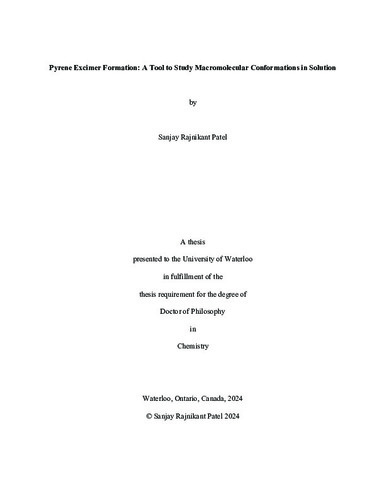| dc.description.abstract | The current view for fluorescence collisional quenching (FCQ) experiments is that no quantitative
information can be retrieved from macromolecules containing more than a single dye-quencher
pair attached at two specific positions on a macromolecule. This holds true for pyrene excimer
formation (PEF), a well-established FCQ phenomenon, where an excimer is produced through the
encounter between an excited and a ground-state pyrenyl labels attached onto a macromolecule.
In contrast, recent studies suggest that the analysis of fluorescence decays acquired with
macromolecules containing many pyrenyl labels with the model free analysis (MFA) and
florescence blob model (FBM) yields quantitative information about the internal dynamics and
local density of macromolecules in solution. The underlying physical principle enabling the MFA
and FBM to probe macromolecules in this manner is based on the direct relationship existing
between the average rate constant (<k>) for PEF and the local concentration ([Py]loc) of pyrenyl
labels on the macromolecule. Yet, and despite its importance, no study has conclusively validated
this relationship. This is due, in part, to the difficulty in determining [Py]loc for pyrene-labeled
macromolecules (PyLM) and benchmarking this methodology against other experimental
techniques. In the present thesis, this fundamental relationship was demonstrated with a series of
polyamidoamine (PAMAM) dendrimers of generations GY (=0, 1, or 2) that had been labeled with
pyrene derivatives having different numbers X (= 4, 8, or 12) of carbon atoms in the pyrenyl linker
to yield the PyCX-PAMAM-GY samples. The fluorescence decays were acquired in N,Ndimethylformamide
(DMF) and dimethylsulfoxide (DMSO) and analyzed with the MFA to
retrieve <k>, which was compared to [Py]loc obtained by assuming that the internal segments of
the PyCX-PAMAM-GY samples linking the pyrenyl labels obeyed Gaussian statistics. The direct
relationship found between <k> and [Py]loc for the PyCX-PAMAM-GY samples provided a
vi
validation for this assumption and demonstrated that PEF can be employed to probe the
conformation of macromolecules in solution.
Subsequently, PEF was applied to probe the conformational changes induced by protonating the
internal tertiary amines of the PyCX-PAMAM-GY samples, showcasing PEF's ability to study
these conformational changes intramolecularly, a feat difficult to achieve by traditional methods
used for characterizing macromolecular conformations in solution.
Expanding beyond dendrimers, PEF was applied to study the conformation of larger
macromolecules like poly(glutamic acid) (PGA) and polynorbornene (PNb) on different length
scales by using 1-pyrenealkylamines with varied alkyl side chains. The fluorescence blob model
(FBM) was applied to determine the number (Nblob
exp) of structural units within a blob, the volume
probed by an excited pyrenyl label, taken as a measure of the local macromolecular density.
Comparison of Nblob
exp with Nblob
MMO obtained through molecular mechanic optimizations
(MMOs) validated PEF's ability to probe macromolecular conformations over different length
scales. The conformation of the Py-PGA constructs was found to remain unchanged when probed
with 1-pyrenealkylamines having different linker lengths reflecting a homogeneous conformation
over different length scales. In contrast, the Py-PNb samples appeared helical and randomly coiled
for the 1-pyrenealkylamines with a shorter and longer linker, respectively, highlighting the
potential of PEF at probing complex macromolecules with heterogeneous conformation across
various length scales.
In conclusion, this thesis further supports the applicability of PEF as a robust experimental
technique for probing the conformations and internal dynamics of macromolecules in solution. | en |

